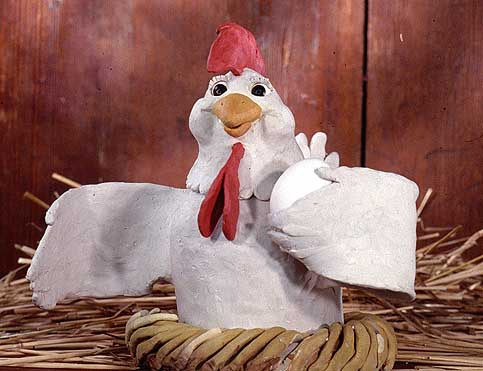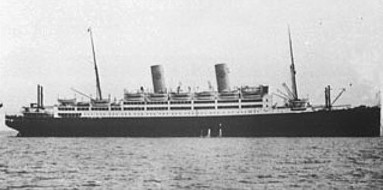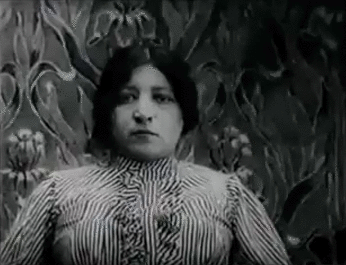|
Puppetoons
''Puppetoons'' is a series of animated puppet films made in Europe (1930s) and in the United States (1940s) by George Pal. They were made using replacement animation: using a series of different hand-carved wooden puppets (or puppet heads or limbs) for each frame in which the puppet moves or changes expression, rather than moving a single puppet, as is the case with most stop motion puppet animation. They were particularly made from 1932-1948, in both Europe and the US. History The Puppetoons series of animated puppet films were made in Europe in the 1930s and in the United States in the 1940s. The series began when George Pal made an advertising film using "dancing" cigarettes in 1932, which led to a series of theatrical advertising shorts for Philips Radio in the Netherlands. This was followed by a series for Horlicks Malted Milk in England. These shorts have an art deco design, often reducing characters to simple geometric shapes. Pal arrived in the U.S. in 1940, and produce ... [...More Info...] [...Related Items...] OR: [Wikipedia] [Google] [Baidu] |
George Pal
George Pal (born György Pál Marczincsak; ; February 1, 1908 – May 2, 1980) was a Hungarian-American animator, film director and producer, principally associated with the fantasy and science-fiction genres. He became an American citizen after emigrating from Europe. He was nominated for Academy Awards (in the category Best Short Subjects, Cartoon) for seven consecutive years (1942–1948) and received an honorary award in 1944. This makes him the second-most nominated Hungarian exile (together with William S. Darling and Ernest Laszlo) after Miklós Rózsa. Early life and career Pal was born in Cegléd, Hungary, as György Gyula Marczincsak the son of Gyula Marczincsak, Sr. and his wife Mária Tikó; in 1936 he officially changed his lastname Marczincsak to "''Pál''", becoming György (George) Pál. He graduated from the Hungarian University of Fine Arts in 1928 (aged 20). From 1928 to 1931, he made films for Hunnia Film Studio of Budapest, Hungary. In 30th June of 1930 in Bu ... [...More Info...] [...Related Items...] OR: [Wikipedia] [Google] [Baidu] |
John Henry And The Inky-Poo
''John Henry and the Inky-Poo'' is a 1946 American stop-motion animated film written and directed by George Pal using Pal's '' Puppetoons'' stop-motion style. The film is based on African American folk hero John Henry. ''John Henry and the Inky-Poo'' was nominated for an Oscar for Best Animated Short for the 19th Academy Awards. In 2015, the film was selected for preservation in the United States National Film Registry by the Library of Congress as being "culturally, historically, or aesthetically significant". It was also included in the 1987 compilation film '' The Puppetoon Movie''. Reception * ''The Film Daily'' (Aug 14, 1946): "In a departure from the fables dreamed up for the familiar scarecrow and the little pickaninny (Jasper Jasper, an aggregate of microgranular quartz and/or cryptocrystalline chalcedony and other mineral phases, is an opaque, impure variety of silica, usually red, yellow, brown or green in color; and rarely blue. The common red color is due ... [...More Info...] [...Related Items...] OR: [Wikipedia] [Google] [Baidu] |
Tubby The Tuba (1947 Film)
''Tubby the Tuba'' is a 1947 American animated short film from Paramount Pictures, directed by George Pal as part of his ''Puppetoons'' series. It was based on the Tubby the Tuba (song), original song by Paul Tripp and George Kleinsinger. The film features narration by Victor Jory. The film received an Academy Award nomination Academy Award for Best Animated Short Film, for Best Animated Short, but lost to Warner Bros. Cartoons' ''Merrie Melodies'' cartoon ''Tweetie Pie''. A Tubby the Tuba (1975 film), feature-length version was released in 1975 by Embassy Pictures, AVCO Embassy. The 1987 compilation feature, ''The Puppetoon Movie'', featured the original short in its entirety. Plot This story takes place in an orchestra featuring, among each other, a piccolo (Peepo), a Western concert flute, flute, an oboe, a clarinet, a bassoon, a trumpet, a French horn, a trombone, a tuba (Tubby), a violin, a cello, a double bass, a xylophone, clash cymbals, cymbals, a timpani and a celesta, ... [...More Info...] [...Related Items...] OR: [Wikipedia] [Google] [Baidu] |
Tulips Shall Grow
''Tulips Shall Grow'' is a 1942 American animated short film in the '' Puppetoons'' series, directed by George Pal and starring Rex Ingram and Victor Jory. It was released by Paramount Pictures and originally photographed in 3-strip Technicolor. It later became the black-and-white edition by National Telefilm Associates. Plot A Dutch boy named Jan and a Dutch girl named Janette find their idyllic existence destroyed when they are overrun by a group of Nazi-like mechanical men called "The Screwballs", who lay waste to everything they touch. The Screwballs are later destroyed by a thunderstorm (the rain of which causes them to rust) and Jan and Janette's idyllic life resumes. Reception The cartoon was nominated for the Oscar for Best Short Subject, Cartoons. In 1997, the film was selected for preservation in the United States National Film Registry by the Library of Congress The Library of Congress (LOC) is a research library in Washington, D.C., serving as the library ... [...More Info...] [...Related Items...] OR: [Wikipedia] [Google] [Baidu] |
The Wonderful World Of The Brothers Grimm
''The Wonderful World of the Brothers Grimm'' is a 1962 American Biographical film, biographical fantasy film directed by Henry Levin (film director), Henry Levin and George Pal. The latter was the producer and also in charge of the stop motion animation. The film was one of the highest-grossing films of 1962. It won one Academy Awards, Oscar and was nominated for three additional Academy Awards. The cast included several prominent actors—including Laurence Harvey, Karlheinz Böhm, Karl Boehm, Jim Backus, Barbara Eden and Buddy Hackett. It was filmed in the Cinerama process, which was photographed in an arc with three lenses, on a camera that produced three strips of film. Three projectors, in the back and sides of the theatre, produced a panoramic image on a screen that curved 146 degrees around the front of the audience. Plot The story focuses on the Brothers Grimm, Grimm brothers, Wilhelm and Jacob, and is biographical and fantastical at the same time. They are working to fi ... [...More Info...] [...Related Items...] OR: [Wikipedia] [Google] [Baidu] |
Stop-motion
Stop-motion (also known as stop frame animation) is an animation, animated filmmaking and special effects technique in which objects are physically manipulated in small increments between individually photographed frames so that they will appear to exhibit independent motion or change when the series of frames is played back. Any kind of object can thus be animated, but puppets with movable joints (puppet animation) or clay figures (claymation) are most commonly used. Puppets, models or clay figures built around an Armature (sculpture), armature are used in model animation. Stop motion with live actors is often referred to as pixilation. Stop motion of flat materials such as paper, fabrics or photographs is usually called cutout animation. Terminology The term "stop-motion", relating to the animation technique, is often spelled without a hyphen as "stop motion"—either standalone or as a compound modifier. Both orthographic variants, with and without the hyphen, are correct, b ... [...More Info...] [...Related Items...] OR: [Wikipedia] [Google] [Baidu] |
And To Think That I Saw It On Mulberry Street
''And to Think That I Saw It on Mulberry Street'' is Theodor Seuss Geisel's first children's book published under the name Dr. Seuss. First published by Vanguard Press in 1937, the story follows a boy named Marco, who describes a parade of imaginary people and vehicles traveling along a road, Mulberry Street, in an elaborate fantasy story he dreams up to tell his father at the end of his walk. However, when he arrives home, he decides instead to tell his father what he actually saw—a simple horse and wagon. Geisel conceived the core of the book aboard a ship in 1936, returning from a European vacation with his wife. The rhythm of the ship's engines captivated him and inspired the book's signature lines: "And that is a story that no one can beat. And to think that I saw it on Mulberry Street." At least 20 publishers rejected the book before Geisel ran into an old college classmate, who had just become juvenile editor at Vanguard Press. Vanguard agreed to publish the book, and ... [...More Info...] [...Related Items...] OR: [Wikipedia] [Google] [Baidu] |
The 500 Hats Of Bartholomew Cubbins
''The 500 Hats of Bartholomew Cubbins'' is a children's book, written and illustrated by Theodor Geisel under the pen name Dr. Seuss and published by Vanguard Press in 1938. Unlike the majority of Geisel's books, it is written in prose rather than rhyming and metered verse. Geisel, who was a collector of hats, got the idea for the story when he was on a commuter train from New York to New England, while sitting behind a businessman wearing a hat. The businessman was so stiff and formal that Geisel idly wondered what would happen if he took the man's hat and threw it out the window, and he artistically, albeit erroneously, concluded that the man would "simply grow a new one". The characters of Bartholomew and King Derwin returned a decade later in '' Bartholomew and the Oobleck''. Plot summary Set in feudal times, the story begins in the Kingdom of Didd. A young peasant boy named Bartholomew Cubbins lives on the outskirts of the kingdom with his family; he wears a simple r ... [...More Info...] [...Related Items...] OR: [Wikipedia] [Google] [Baidu] |
National Telefilm Associates
National Telefilm Associates (NTA) was a distribution company primarily concerned with the syndication of American film libraries to television, including the Republic Pictures film library. It was successful enough on cable television between 1983 and 1985 that it renamed itself Republic Pictures and undertook film production and home video sales as well. History NTA was founded by Ely Landau and Oliver A. Unger in 1954 when Ely Landau, Inc. was reorganized in partnership with Unger and Harold Goldman. NTA was the successor company to U.M. & M. TV Corporation, which it bought out in 1956. In October 1956, NTA launched the NTA Film Network, a broadcast syndication, syndication service which distributed both film and live programs to television stations not affiliated with NBC, CBS, or American Broadcasting Company, ABC (DuMont Television Network, DuMont had recently gone out of business). The ad-hoc network's flagship station was WNET, WNTA-TV, channel 13 in New York. The NTA Net ... [...More Info...] [...Related Items...] OR: [Wikipedia] [Google] [Baidu] |
Animation
Animation is a filmmaking technique whereby still images are manipulated to create moving images. In traditional animation, images are drawn or painted by hand on transparent celluloid sheets to be photographed and exhibited on film. Animation has been recognised as an artistic medium, specifically within the entertainment industry. Many animations are either traditional animations or computer animations made with computer-generated imagery (CGI). Stop motion animation, in particular claymation, has continued to exist alongside these other forms. Animation is contrasted with live action, although the two do not exist in isolation. Many moviemakers have produced films that are a hybrid of the two. As CGI increasingly approximates photographic imagery, filmmakers can easily composite 3D animations into their film rather than using practical effects for showy visual effects (VFX). General overview Computer animation can be very detailed 3D animation, while 2D c ... [...More Info...] [...Related Items...] OR: [Wikipedia] [Google] [Baidu] |
Stop Motion
Stop-motion (also known as stop frame animation) is an animated filmmaking and special effects technique in which objects are physically manipulated in small increments between individually photographed frames so that they will appear to exhibit independent motion or change when the series of frames is played back. Any kind of object can thus be animated, but puppets with movable joints (puppet animation) or clay figures (claymation) are most commonly used. Puppets, models or clay figures built around an armature are used in model animation. Stop motion with live actors is often referred to as pixilation. Stop motion of flat materials such as paper, fabrics or photographs is usually called cutout animation. Terminology The term "stop-motion", relating to the animation technique, is often spelled without a hyphen as "stop motion"—either standalone or as a compound modifier. Both orthographic variants, with and without the hyphen, are correct, but the hyphenated one is th ... [...More Info...] [...Related Items...] OR: [Wikipedia] [Google] [Baidu] |
Folklore Of The United States
American folklore encompasses the folklore that has evolved in the present-day United States mostly since the European colonization of the Americas. It also contains folklore that dates back to the Pre-Columbian era. Folklore consists of legends, music, oral history, proverbs, jokes, popular beliefs, fairy tales, stories, tall tales, and customs that are the traditions of a culture, subculture, or group. It is also the set of practices through which those expressive genres are shared. Native American folk Native American cultures are rich in myths and legends that explain natural phenomena and the relationship between humans and the spirit world. According to Barre Toelken, feathers, beadwork, dance steps and music, the events in a story, the shape of a dwelling, or items of traditional food can be viewed as icons of cultural meaning. Toelken, Barrebr>''The Anguish of Snails'', Utah State University Press, 2003 Native American cultures are numerous and diverse. Though some ... [...More Info...] [...Related Items...] OR: [Wikipedia] [Google] [Baidu] |



